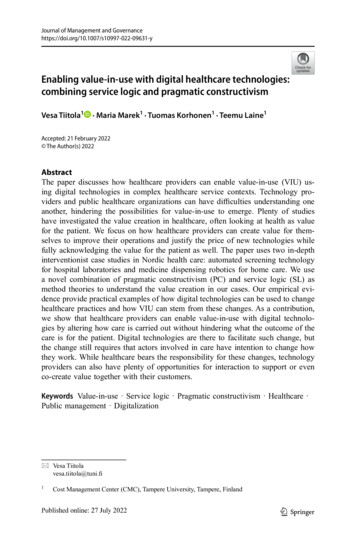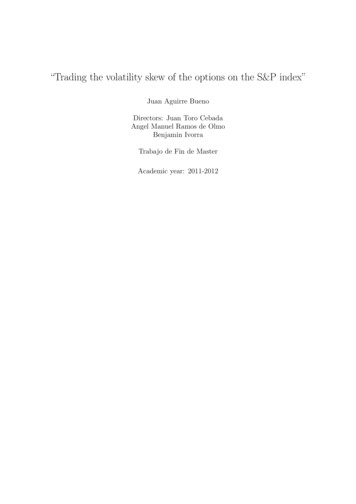
Transcription
Journal of Management and -yEnabling value-in-use with digital healthcare technologies:combining service logic and pragmatic constructivismVesa Tiitola1· Maria Marek1 · Tuomas Korhonen1 · Teemu Laine1Accepted: 21 February 2022 The Author(s) 2022AbstractThe paper discusses how healthcare providers can enable value-in-use (VIU) using digital technologies in complex healthcare service contexts. Technology providers and public healthcare organizations can have difficulties understanding oneanother, hindering the possibilities for value-in-use to emerge. Plenty of studieshave investigated the value creation in healthcare, often looking at health as valuefor the patient. We focus on how healthcare providers can create value for themselves to improve their operations and justify the price of new technologies whilefully acknowledging the value for the patient as well. The paper uses two in-depthinterventionist case studies in Nordic health care: automated screening technologyfor hospital laboratories and medicine dispensing robotics for home care. We usea novel combination of pragmatic constructivism (PC) and service logic (SL) asmethod theories to understand the value creation in our cases. Our empirical evidence provide practical examples of how digital technologies can be used to changehealthcare practices and how VIU can stem from these changes. As a contribution,we show that healthcare providers can enable value-in-use with digital technologies by altering how care is carried out without hindering what the outcome of thecare is for the patient. Digital technologies are there to facilitate such change, butthe change still requires that actors involved in care have intention to change howthey work. While healthcare bears the responsibility for these changes, technologyproviders can also have plenty of opportunities for interaction to support or evenco-create value together with their customers.Keywords Value-in-use · Service logic · Pragmatic constructivism · Healthcare ·Public management · DigitalizationVesa Tiitolavesa.tiitola@tuni.fi1Cost Management Center (CMC), Tampere University, Tampere, Finland13
V. Tiitola et al.1 IntroductionIn our paper, we examine the creation of value and the value-in-use that emergesfor the healthcare providers when new digital technologies are introduced to complex healthcare contexts. In the public Business-to-Government (B2G) setting, oneimportant problem of digitalization is that it is difficult for technology providers tounderstand the public management context, its complex stakeholder networks and itsactual service processes, and vice versa, for healthcare providers to fully understandthe possibilities enabled by the new technologies (Autioniemi, 2020; Balta et al.,2021; Eloranta, 1986). Tax-payers’ money is possibly lost due to difficulties in understanding what is required to enable value creation in the public sector in the longterm (Lindholm et al., 2019). Not only should the new technologies provide betterhealth outcomes for patients, but they can also help improve the operations of healthcare actors to justify the cost of the technologies. By examining and understandingorganisational action in times of change (Stenvall & Virtanen, 2017) we can revealthe foundations of value (Wilden et al., 2017), i.e., how value can be created usingdigital technologies. A natural approach for this value-in-use (VIU) concept (e.g.,Grönroos 2008; 2011; Grönroos & Helle, 2010; Grönroos & Voima, 2013; Yu et al.,2019), which enables us grasp how the value of digitalization emerges in specific usecontexts.VIU is a central concept in service logic and can be defined as the outcome of aprocess in which the customers integrate their suppliers’ resources (i.e., digital technologies) within their own operations (Yu et al., 2019, p. 181) with the purpose ofchanging their practice. Some advances have been made in the application of theVIU concept of service logic in public management (e.g., Grönroos 2019) and inhealthcare (e.g., Davey & Grönroos 2019) and literature on healthcare technologyimplementations and its challenges already acknowledges that these technologiesalso require a change in practice (e.g., Nilsen et al., 2016). However, they do notexplicitly examine what changes in practice are required, and furthermore, how valueemerges from these changes. For example, a recent paper by Balta et al., (2021) discusses the value co-creation in healthcare stakeholder networks, but they focus onhow digital technologies could be used to co-create value through empowerment ofstakeholders, not on how the existing care processes can be altered to create valuewith these digital technologies. Moreover, the idea of value being embedded as afeature of technologies still dominates in practice. According to service logic (as wellas service-dominant logic), technology does not intrinsically create value; instead,VIU emerges from the actions of customers using these technologies with the supportof suppliers (Grönroos & Voima, 2013). Moreover, due to the complex and dynamicnature of the customers role in value creation (Grönroos, 2011), individual actor’sactions and worldviews should be investigated to understand how VIU can emerge inpractice. It is especially important to examine what is required and by whom for VIUto emerge especially in the B2G sector, where multiple actors representing differentmotives and values can influence how healthcare is carried out (Balta et al., 2021).While some studies look value creation in healthcare contexts from a networkperspective (e.g., Balta et al., 2021) studies on healthcare services typically focus onvalue for the customer (e.g., Grönroos 2019), and with a good reason. However, in13
Enabling value-in-use with digital healthcare technologies: combining some cases this marginal value created can result in an unreasonably expense for thehealthcare providers or even hindering the care of other patients (e.g., prioritizingpatients). However, even if the end goal is providing “better health” for the patients,the organizations and municipalities still have to think if the new digital technologiesare worth the price. Thus, we focus on how healthcare organizations can streamlinetheir own operations with digital technologies and do so without compromising thecare of the patients. To investigate the creation of VIU in healthcare contexts, weuniquely combine two, previously separate approaches to provide a more powerfulconceptual background. First, we use Service Logic (SL) to understand mechanismsof value creation, and second, we use pragmatic constructivism (PC) to understandactors’ interaction and intentionalities for creating value. By combining these separate, but compatible theoretical approaches, we can examine the different intentionalities for value creation in value networks that drive VIU. In so doing, the paperproposes that SL and PC, as an approach to understanding intention for action (Nørreklit, 2017a, b), can support the identification of those actions required for VIUto emerge as well as any possible challenges therein. After all, challenges such aschange resistance and institutionalized public procurement practices might not necessarily emphasize customer value as much as purchase price (Landaeta et al., 2008;Lindholm et al., 2019; Nilsen et al., 2016).This paper utilizes a combinatory approach of SL and PC to understanding thevalue-in-use enabled by healthcare technologies. We examine how healthcare providers can manage the complexity increasing due to digitalization of healthcare, i.e.,healthcare technology implementation, to enable VIU to emerge in public healthcare service contexts. We provide practical examples of complex healthcare contextswhere digital technologies can help healthcare enable VIU, which can help us better understand the mechanisms and possibilities for using future digital technologiesin various healthcare contexts to create value. More specifically, the paper seeks toanswer the followin
vice logic view of customer value and on the nature of a pragmatic constructivism approach to public healthcare and healthcare technologies, building a framework combining these two viewpoints. The third chapter will present the methodology used in the two cases, followed by the empirical ndings in the fourth chapter. Finally, the











